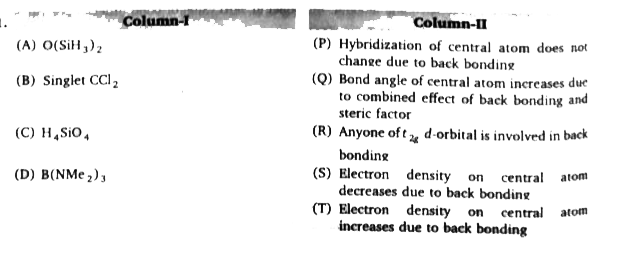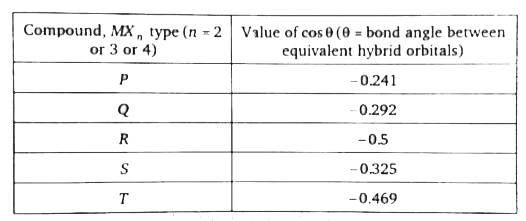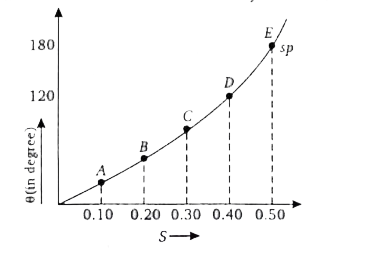Drago suggested an emprical rule which is compatible with the energetics of hybridization. It will occupy a stereochemically inactive s-orbital, and the bonding will be through p-orbitals and bond angles will be nearly 90∘ if the electronegativity of the surrounding atoms is ≤2.5.
Q. In which of the following molecule central atom has higher % s-character in its bond pair:
AsH3
GeH4
P4
H2Se
The correct Answer is:B
To determine which molecule has a central atom with the highest percentage of s-character in its bond pairs according to Drago's empirical rule, we will analyze the given options step by step.
Step 1: Understand Drago's Rule
Drago's rule states that:
1. The central atom should have at least one lone pair of electrons.
2. The central atom should belong to group 13 to 16 or from the 3rd to 7th period.
3. The electronegativity of the surrounding atoms should be less than or equal to 2.5.
4. If there are four lone pairs, sigma bonds are absent.
Step 2: Analyze Each Molecule
We will analyze the central atom of each molecule provided in the options to determine the percentage of s-character.
1. Arsenic (As) in Arsenic Compounds (e.g., AsH3):
- Group: 15 (has 5 valence electrons)
- Lone pairs: 1 (3 used for bonding)
- Hybridization: None needed according to Drago's rule.
- s-character: 33.33% (since it can be considered as having sp3 hybridization if needed).
2. Germanium (Ge) in GeH4:
- Group: 14 (has 4 valence electrons)
- Lone pairs: 0 (all electrons are used for bonding)
- Hybridization: sp3 (due to 4 bonds).
- s-character: 25%.
3. Phosphorus (P) in P4:
- Group: 15 (has 5 valence electrons)
- Lone pairs: 1 (3 used for bonding with other P atoms)
- Hybridization: None needed according to Drago's rule.
- s-character: 33.33%.
4. Selenium (Se) in H2Se:
- Group: 16 (has 6 valence electrons)
- Lone pairs: 2 (2 used for bonding with H)
- Hybridization: None needed according to Drago's rule.
- s-character: 50% (considering it as having sp2 hybridization).
Step 3: Compare s-Character
Now we compare the percentage of s-character in the bond pairs of the central atoms:
- As: 33.33%
- Ge: 25%
- P: 33.33%
- Se: 50%
Conclusion
The molecule with the central atom that has the highest percentage of s-character is H2Se, where selenium has 50% s-character in its bond pairs.
Final Answer
H2Se has the highest percentage of s-character in its bond pair.
---
Drago's rule states that:
1. The central atom should have at least one lone pair of electrons.
2. The central atom should belong to group 13 to 16 or from the 3rd to 7th period.
3. The electronegativity of the surrounding atoms should be less than or equal to 2.5.
4. If there are four lone pairs, sigma bonds are absent.
We will analyze the central atom of each molecule provided in the options to determine the percentage of s-character.
- Group: 15 (has 5 valence electrons)
- Lone pairs: 1 (3 used for bonding)
- Hybridization: None needed according to Drago's rule.
- s-character: 33.33% (since it can be considered as having sp3 hybridization if needed).
- Group: 14 (has 4 valence electrons)
- Lone pairs: 0 (all electrons are used for bonding)
- Hybridization: sp3 (due to 4 bonds).
- s-character: 25%.
- Group: 15 (has 5 valence electrons)
- Lone pairs: 1 (3 used for bonding with other P atoms)
- Hybridization: None needed according to Drago's rule.
- s-character: 33.33%.
- Group: 16 (has 6 valence electrons)
- Lone pairs: 2 (2 used for bonding with H)
- Hybridization: None needed according to Drago's rule.
- s-character: 50% (considering it as having sp2 hybridization).
Now we compare the percentage of s-character in the bond pairs of the central atoms:
- As: 33.33%
- Ge: 25%
- P: 33.33%
- Se: 50%
The molecule with the central atom that has the highest percentage of s-character is H2Se, where selenium has 50% s-character in its bond pairs.
H2Se has the highest percentage of s-character in its bond pair.
Topper's Solved these Questions
- CHEMICAL BONDING (ADVANCED)BOOK - VK JAISWAL ENGLISHCHAPTER - CHEMICAL BONDING (ADVANCED)EXERCISE - ONE OR MORE ANSWER IS/ARE CORRECT
78 Videos
- CHEMICAL BONDING (ADVANCED)BOOK - VK JAISWAL ENGLISHCHAPTER - CHEMICAL BONDING (ADVANCED)EXERCISE - MATCH THE COLUMN
21 Videos
- CHEMICAL BONDING (ADVANCED)BOOK - VK JAISWAL ENGLISHCHAPTER - CHEMICAL BONDING (ADVANCED)EXERCISE - Level 2
150 Videos
- CHEMICAL BONDING (BASIC)BOOK - VK JAISWAL ENGLISHCHAPTER - CHEMICAL BONDING (BASIC)EXERCISE - SUBJECTIVE PROBLEMS
54 Videos
Similar Questions
Which is correct statement ?
View SolutionColumn-I and Column-II contains four entries each. Entries of Column -I are to be matched with some entries of Column-II. One or more than one entries of Column-I may have the matching with the same entries of Column-II.

View SolutionConsider the given figure showing the formation of H+2 ion depending on intermuclear distance versus potential energy of the system.

View SolutionConsider following compounds A to E :
(A) XeFn (B)XeF+(n+1) (C)XeF−(n+1) (D)XeF(n+2)
(E ) XeF2−(n+4),
If value of n is 4, then calculate value of p÷q here, 'p' is total number of bond pair and 'q' is total number of lone pair on central atoms of compounds (A) to (E ).
View SolutionTwo hybrid orbitals have a bond angle of 120^(@) . The percentage of p character in the hybrid orbital is nearly :-
View SolutionIf the central atom is of third row or below this in the periodic table, then lone pair will occupy a stereochemically inactive s-orbital and bonding will be through almost pure p-orbitals and bond angles are nearly 90∘, if the substituent's electronegativity value is ≤2.5.
In which of the following option, covalent bond is having maximum s% character ?
View SolutionIf the central atom is of third row or below this in the periodic table, then lone pair will occupy a stereochemically inactive s-orbital and bonding will be through almost pure p-orbitals and bond angles are nearly 90^(@) , if the substituent's electronegativity value is le 2.5 . Select incorrect statement regarding P_(4) molecule.
View SolutionTwo hybrid orbitals have a bond angle of 120^(@) . The percentage of s-character in the hybrid orbitals is nearly:
View SolutionDrago suggested an emprical rule which is compatible with the energetics of hybridization. It will occupy a stereochemically inactive s-orbital, and the bonding will be through p-orbitals and bond angles will be nearly 90∘ if the electronegativity of the surrounding atoms is ≤2.5.
Q. In which of the following molecule central atom has higher % s-character in its bond pair:
View SolutionDrago suggested an emprical rule which is compatible with the energetics of hybridization. It will occupy a stereochemically inactive s-orbital, and the bonding will be through p-orbitals and bond angles will be nearly 90∘ if the electronegativity of the surrounding atoms is ≤2.5.
Q. Correct order of bond angle is :
View SolutionIf the central atom is of third row or below this in the periodic table, then lone pair will occupy a stereochemically inactive s-orbital and bonding will be through almost pure p-orbitals and bond angles are nearly 90^(@) , if the substituent's electronegativity value is le 2.5 . In which of the following option, covalent bond is having maximum s% character ?
View SolutionIf the central atom is of third row or below this in the periodic table, then lone pair will occupy a stereochemically inactive s-orbital and bonding will be through almost pure p-orbitals and bond angles are nearly 90^(@) , if the substituent's electronegativity value is le 2.5 . Select incorrect statement regarding P_(4) molecule.
View Solution
In all expected compounds each central atom only uses its s and p-orbitals in hybridization. The relationship between bond angle 'θ' and decimal fraction of s and p character present in the equivalent orbitals is given by :
cosθ=SS−1=P−1P, S=decimal fraction of s-character in the equivalent hybrid orbital and P=decimal fraction of p-character in the equivalent hybrid orbital.
 .
.
Q. The correct order of % p-character in bond pairs of central atoms in the following compounds is :
View SolutionDrago suggested an emprical rule which is compatible with the energetics of hybridization. It will occupy a stereochemically inactive s-orbital, and the bonding will be through p-orbitals and bond angles will be nearly 90^(@) if the electronegativity of the surrounding atoms is le2.5 . Q. In which of the following molecule central atom has higher % s-character in its bond pair:
View SolutionDrago suggested an emprical rule which is compatible with the energetics of hybridization. It will occupy a stereochemically inactive s-orbital, and the bonding will be through p-orbitals and bond angles will be nearly 90^(@) if the electronegativity of the surrounding atoms is le2.5 . Q. Correct order of bond angle is :
View SolutionTwo hybrid orbitals have a bond angle of 120^(@) . The percentage of p-character in the hybrid orbital is nearly:-
View Solution
